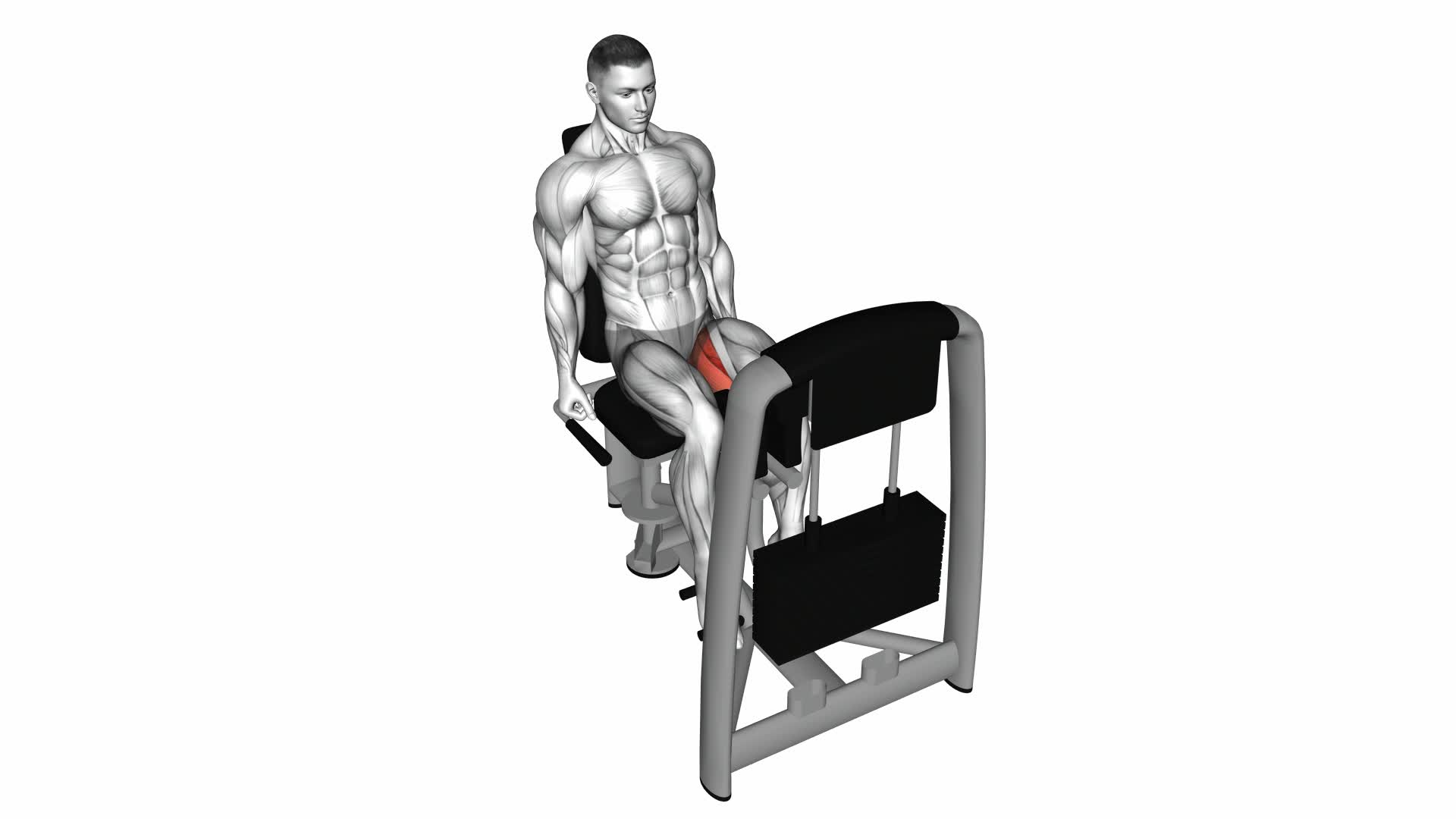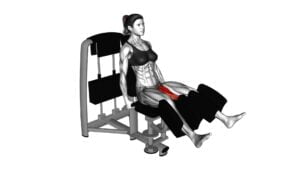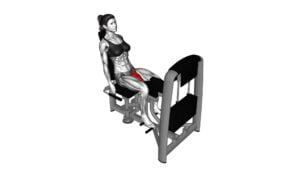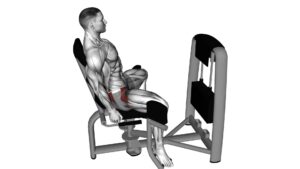Lever Seated Hip Adduction – Video Exercise Guide & Tips

Looking to tone your hip muscles? Get ready to try lever seated hip adduction!
Watch This Exercise Video
This exercise targets your inner thighs and glutes, helping to strengthen and tone those areas.
In this video exercise guide, you'll learn the proper form and technique, as well as common mistakes to avoid.
Plus, we'll share tips for increasing the intensity and variations to keep things interesting.
So, grab a seat and get ready to work those hip muscles!
Key Takeaways
- Lever seated hip adduction targets and strengthens the inner thighs and glutes.
- Proper form and technique, such as engaging the core muscles and maintaining a straight back, are essential for this exercise.
- Common mistakes to avoid include using too much weight, straining the lower back, and forgetting to breathe properly.
- Increasing the intensity of the exercise can be achieved through progressive overload, such as increasing resistance or range of motion, and performing supersets or dropsets.
Benefits of Lever Seated Hip Adduction
You will experience increased hip strength and stability through regular practice of Lever Seated Hip Adduction. This exercise specifically targets the adductor muscles of the hip, which are responsible for bringing the legs together. By engaging these muscles, you can improve your overall lower body strength and enhance your performance in activities that involve hip stability and control.
One of the key health benefits of Lever Seated Hip Adduction is improved muscle activation. This exercise activates the adductor muscles, including the adductor longus, adductor magnus, and adductor brevis. These muscles play a vital role in stabilizing the hip joint and supporting movements such as walking, running, and jumping. By strengthening these muscles, you can reduce the risk of injuries and enhance your overall athletic performance.
Additionally, Lever Seated Hip Adduction can help improve your hip flexibility. As you perform this exercise, you're required to move your legs toward the center, which helps to stretch and lengthen the adductor muscles. This increased flexibility can translate into improved range of motion in your daily activities and sports.
Proper Form and Technique
To maintain proper form and technique during Lever Seated Hip Adduction, focus on engaging your core muscles and keeping your back straight. This exercise is great for improving hip strength and preventing injuries.
When performing the Lever Seated Hip Adduction, start by adjusting the machine's seat height so that your knees are at a 90-degree angle. Sit on the machine with your back straight, shoulders relaxed, and feet flat on the footrests. Place your inner thighs against the pads and grip the handles for stability.
As you exhale, use your inner thigh muscles to bring your legs together, against the resistance of the machine. Hold the contraction for a moment and then slowly return to the starting position. Remember to keep your back straight throughout the movement and avoid rounding your shoulders or arching your lower back.
Engaging your core muscles will help stabilize your body and ensure proper alignment. By maintaining the correct form and technique, you'll maximize the effectiveness of the exercise and reduce the risk of injury.
Common Mistakes to Avoid
Avoiding these mistakes will ensure that you get the most out of your Lever Seated Hip Adduction exercise and minimize the risk of injury.
When performing this exercise, it's important to pay attention to proper technique in order to achieve optimal results.
One common mistake to avoid is using too much weight. While it may be tempting to increase the resistance, using excessive weight can compromise your form and lead to injury. It's crucial to start with a weight that allows you to maintain proper form throughout the entire movement.
Another common mistake isn't maintaining proper posture. It's important to keep your back straight and your core engaged throughout the exercise. Avoid slouching or rounding your shoulders, as this can put unnecessary strain on your lower back.
Additionally, be mindful of your breathing. Many people forget to breathe properly when performing this exercise, which can lead to dizziness or lightheadedness. Remember to inhale during the eccentric phase (when you bring your legs together) and exhale during the concentric phase (when you push your legs apart).
By avoiding these common mistakes and focusing on proper technique, you can maximize the effectiveness of your Lever Seated Hip Adduction exercise.
Now that you understand the mistakes to avoid, let's move on to the next section, which will provide you with tips for increasing the intensity of your workout.
Tips for Increasing Intensity
To increase the intensity of your Lever Seated Hip Adduction exercise, focus on incorporating progressive overload into your routine. This means gradually increasing the resistance or difficulty of the exercise over time to continually challenge your muscles.
Here are some advanced techniques to help you increase the intensity:
- Increase the weight: Use a heavier resistance or add weight plates to the lever machine to provide greater resistance for your hip muscles.
- Slow down the tempo: Perform the exercise at a slower pace, focusing on controlled and deliberate movements. This can increase the time under tension and make the exercise more challenging.
- Increase the range of motion: Instead of stopping when your thighs are parallel to the ground, try going deeper and bringing your thighs closer together. This will engage the hip muscles more effectively.
- Perform supersets or dropsets: Incorporate supersets by pairing the Lever Seated Hip Adduction exercise with another lower body exercise, such as squats or lunges, without taking a break in between. Alternatively, try dropsets by gradually reducing the resistance during a set, allowing you to perform more repetitions at a higher intensity.
Variations and Modifications
To further challenge your hip muscles and add variety to your workout routine, try incorporating different variations and modifications of the Lever Seated Hip Adduction exercise.
By progressing the exercise, you can continue to strengthen and tone your hip muscles.
One way to progress the Lever Seated Hip Adduction is by increasing the resistance. You can do this by adding weight to the machine or using a resistance band around your knees. This will make the exercise more challenging and help you build more strength in your hip muscles.
Another variation you can try is the Single-Leg Lever Seated Hip Adduction. Instead of using both legs, you'll only use one leg at a time. This variation targets each hip individually and can help correct any imbalances between your left and right hips.
If you're looking for equipment options to perform the Lever Seated Hip Adduction exercise, you can use a lever machine at the gym or a resistance band at home. Both options provide effective ways to target and strengthen your hip muscles.
Incorporating these variations and modifications into your routine won't only keep your workouts interesting but also allow you to continue challenging your hip muscles.
Remember to start with a weight or resistance level that's appropriate for your fitness level and gradually increase as you get stronger.
Frequently Asked Questions
Is Lever Seated Hip Adduction Suitable for Beginners?
Yes, lever seated hip adduction is suitable for beginners. It's a great exercise to strengthen your hip muscles and improve stability. Starting with light resistance and gradually increasing it can help you progress in this exercise.
Lever seated hip adduction is beneficial for strength training as it targets the inner thigh muscles and can help improve overall lower body strength. Incorporating this exercise into your routine can contribute to your fitness goals.
Can Lever Seated Hip Adduction Help With Hip Pain or Discomfort?
Lever seated hip adduction can be beneficial for relieving hip pain or discomfort. By targeting the hip muscles, this exercise can help improve strength and stability in the hip joint.
The controlled movement of the lever allows for targeted activation of the adductor muscles, which can help alleviate pain and discomfort. Beginners can also benefit from this exercise as it provides a controlled and supported movement, allowing for gradual progression and reduced risk of injury.
How Often Should Lever Seated Hip Adduction Be Performed for Optimal Results?
To achieve optimal results, it's important to perform lever seated hip adduction exercises regularly. The frequency of these exercises will depend on your individual goals and fitness level.
However, for most individuals, performing lever seated hip adduction exercises 2-3 times per week is a good starting point.
It's also worth noting that lever seated hip adduction exercises can be suitable for beginners, as long as they start with light resistance and focus on proper form.
Are There Any Alternative Exercises That Target the Same Muscle Group as Lever Seated Hip Adduction?
If you're looking for alternative exercises that target the same muscle group as lever seated hip adduction, there are a few options to consider.
By incorporating exercises like standing hip adductions, cable hip adductions, or lateral lunges, you can effectively work the same muscles.
These exercises focus on the adductor muscles of the hips and can provide a great alternative to the lever seated hip adduction exercise.
What Are Some Precautions or Contraindications for Performing Lever Seated Hip Adduction?
When performing lever seated hip adduction, it's important to be aware of certain precautions and contraindications.
Precautions include avoiding this exercise if you have any hip or knee injuries, as it could worsen the condition. Additionally, individuals with lower back issues should use caution and consult with a healthcare professional before attempting this exercise.
Contraindications for lever seated hip adduction include pregnancy, herniated discs, and any other conditions that may be aggravated by hip adduction movements.
Conclusion
In conclusion, lever seated hip adduction is a beneficial exercise that targets the inner thigh muscles. By maintaining proper form and avoiding common mistakes, you can maximize the effectiveness of this exercise.
To increase intensity, consider adding resistance or adjusting the machine settings. Additionally, variations and modifications can be incorporated to add variety and challenge to your workout routine.
Remember to consult with a fitness professional to ensure proper technique and avoid injury.

Author
Years ago, the spark of my life’s passion ignited in my mind the moment I stepped into the local gym for the first time. The inaugural bead of perspiration, the initial endeavor, the very first surge of endorphins, and a sense of pride that washed over me post-workout marked the beginning of my deep-seated interest in strength sports, fitness, and sports nutrition. This very curiosity blossomed rapidly into a profound fascination, propelling me to earn a Master’s degree in Physical Education from the Academy of Physical Education in Krakow, followed by a Sports Manager diploma from the Jagiellonian University. My journey of growth led me to gain more specialized qualifications, such as being a certified personal trainer with a focus on sports dietetics, a lifeguard, and an instructor for wellness and corrective gymnastics. Theoretical knowledge paired seamlessly with practical experience, reinforcing my belief that the transformation of individuals under my guidance was also a reflection of my personal growth. This belief holds true even today. Each day, I strive to push the boundaries and explore new realms. These realms gently elevate me to greater heights. The unique combination of passion for my field and the continuous quest for growth fuels my drive to break new ground.







